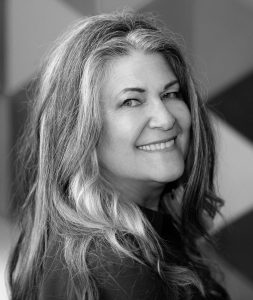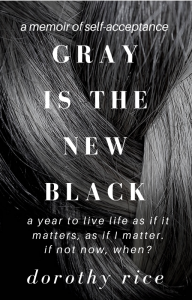Does Writing Foster Self-Acceptance?
 by Dorothy Rice
by Dorothy Rice
The question gives me pause. It shouldn’t. I recently published Gray Is the New Black: A Memoir of Self-Acceptance (Otis Books, 2019). It’s right there in the subtitle. Yet as I sit on the couch sipping coffee and struggling to find the right words, I have a confession. The journey isn’t over.
Gray (the acronym, GITNB, sounds too much like an insurance company) isn’t a glossy self-help book. It doesn’t chart my uphill journey from low self-esteem to self-love, or provide a how-to for transitioning gracefully to gray.
I wrote Gray out of desperation, as an attempt to come to terms with why, at 63, I still went to bed each night, and woke each morning, feeling inadequate, dissatisfied, unfulfilled, believing there must be some better destination I needed to reach, some better person I needed to become. This had been my reality for as long as I could remember. I’d spent a lifetime striving, longing, to transform into someone, something, other than who and what I was.
I was 63 and afraid, of waking up in 20 years, or even 5, still asking, is this all there is? I did not want to waste any more precious time grappling with regret and disappointment, as I’d watched my own mother do in her final years, up until she was lost to Alzheimer’s.
If not now, when? That was the question that drove the outpouring of words that became Gray. Going gray, accepting and making the most of my hair’s literal, visual transformation, became a metaphor for the broader journey.
Determined to find my way out of the box I was in, I decided to spend a year – 2017 – searching for root causes and yanking them out. For a year, I dug deep. What flowed from my pen were painful, long-pushed aside memories – of rape at 15 and the years of encounters with my abuser that followed. This had been the dark secret of my adolescence. A secret I’d harbored for close to 50 years.
Through remembering, reliving, writing and reflecting, I began to realize how profoundly those degrading, dehumanizing encounters had shaped my sense of who I am as a woman. I had internalized the belief that I was ugly, undesirable, unworthy of love. Beliefs that triggered body dysmorphia, food addictions, depression and chronic migraines.
What kind of girl does what I did? Guilt and shame tainted subsequent relationships and lowered my expectations of what I deserved. Guilt and shame kept me from expecting to be loved and treated with kindness and respect, and made me distrust goodness in others when it did find me.
It’s not as if my life hadn’t been, by many measures, a good one. In most of the visible ways, I’d been successful. Yet emotionally, viscerally, that lonely teenage girl who once accepted a ride from a stranger, still lived in my bones.
.
Writing the initial draft of Gray was both painful – like ripping off old scabs – and cathartic. Taking an emotional step away from the page, then returning to do the hard work of reflection, revision and editing, allowed me to find the universality in my stories, to see the sadness and the humor, and to more generously appreciate the rich mosaic of my lived life. As mother, grandmother, wife, sister, friend, writer, woman.
Reconstructing painful memories as scenes, with myself and the heroes and villains of my stories as characters, allowed me the distance I needed for the slow process of forgiveness and self-acceptance to begin.
Through writing, I was able recreate and relive past events with the perspective allowed by time and experience. Through older eyes, memories captured and frozen in childhood, adolescence and early adulthood, revealed unexpected details, nuances and interpretations that hadn’t been possible before.
Since the publication of Gray Is the New Black a year ago, I’ve heard from dozens of women who saw themselves, their own experiences, self-limiting beliefs and pain, in my stories. Finding these connections has helped me realize I’m not alone, that I was never alone.
Like life itself, self-acceptance is a journey. If I were allowed only one tool to bring with me on the journey, it would be writing. Mining memory to craft life stories that ring true and shine new light on the past, has become map, compass, guidebook, translator, therapist, life coach, and more. A veritable Swiss Army Knife for accessing worlds beyond my personal lived experience, and the worlds I harbor within.
In her classic essay, “Memory and Imagination,” Patricia Hampl writes, “To write one’s own life is to live it twice, and the second living is both spiritual and historical, for the memoir reaches deep within the personality as it seeks its narrative form and also grasps the life-of-the-times as no political treatise can.” Finding my life’s narrative form has allowed me to turn over old rocks and let healing begin, rather than harboring secrets and allowing them to fester in the subconscious, pinning me to the past.
Am I cured? Do I love myself unconditionally? Do I no longer wish I were thinner, prettier, sexier, a better wife and mother, a big-time famous writer? Well, no, not exactly. I still fall into those well-worn mental grooves from time to time. Though nowadays, when I comb my long, multi-hued gray hair in the mirror, I’m more likely to smile than despair.
I mean, seriously, I’m 66. Life is good. Writing is good. Both keep me learning, sharing and growing.
GRAY IS THE NEW BLACK
 The wry and relatable narrator of GRAY IS THE NEW BLACK–a memoir of ageism, sexism and self-acceptance–came of age in the psychedelic sixties. Now in her sixties, it’s time to take stock. After decades struggling to be thin enough, pretty, sexy and successful enough to deserve love and happiness, she devotes a year to cracking the code, a journey that forces her to confront the gnarled roots of female shame. If you have a complicated relationship with your mother, food, your hair, your body, the past, or your partner, you will likely find GRAY IS THE NEW BLACK a page-turning, resonant, and engaging read.
The wry and relatable narrator of GRAY IS THE NEW BLACK–a memoir of ageism, sexism and self-acceptance–came of age in the psychedelic sixties. Now in her sixties, it’s time to take stock. After decades struggling to be thin enough, pretty, sexy and successful enough to deserve love and happiness, she devotes a year to cracking the code, a journey that forces her to confront the gnarled roots of female shame. If you have a complicated relationship with your mother, food, your hair, your body, the past, or your partner, you will likely find GRAY IS THE NEW BLACK a page-turning, resonant, and engaging read.
Category: Contemporary Women Writers, How To and Tips






























